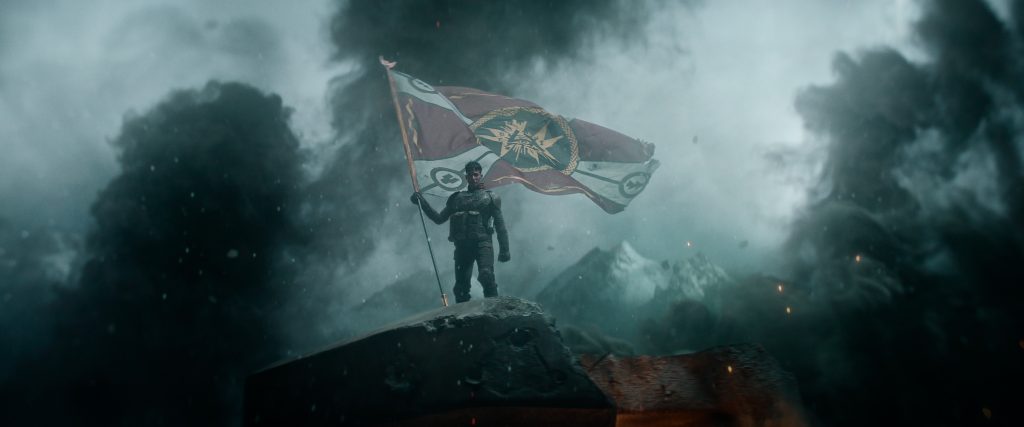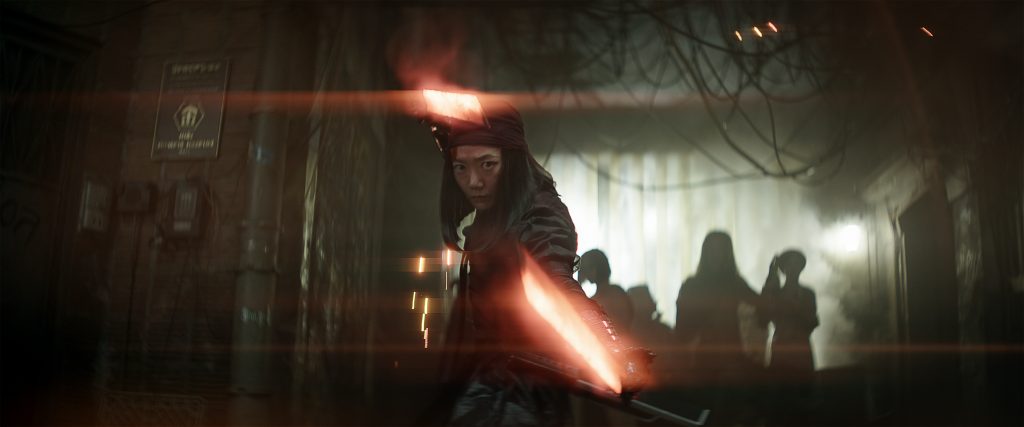Review: REBEL MOON Isn’t Anything New or Interesting

 Rebel Moon: Part One – A Child of Fire (2023)
Rebel Moon: Part One – A Child of Fire (2023)
Screenplay by Zack Snyder & Kurt Johnstad & Shay Hatten
Story by Zack Snyder
Produced by Zack Snyder, Deborah Snyder, Wesley Coller, Eric Newman
Directed by Zack Snyder
Rated PG-13, 2hr 15m
Once you get past the space vagina and the Star Destroyer stand-in moving past the screen while Anthony Hopkins reads the very long rollup that should have been on-screen text and shorter, it’s obvious that Rebel Moon is a Star Wars film with a different paint job. And once you get past the fact that it’s Star Wars with the serial numbers filed off, you then realize that it’s actually Seven Samurai in Space from Wish.com.
In other words, Zack Snyder isn’t giving us anything new. At all.
That’s not to say I wasn’t entertained. I didn’t hate it. It kept my attention for a couple of hours, but at no point did I care about anyone in the story. Snyder’s script is a paint-by-numbers amalgamation of tropes from all sorts of other films, and I have to wonder now if Snyder is relying too heavily on the shorthand model. As we’ve discussed on a number of occasions, there are times when storytellers will use archetypes to convey ideas — the callow youth, the sage old wizard, the damsel in distress, the moustache-twirling villain — but after a while, those archetypes have a way of becoming pastiches, two-dimensional and flat representations of an idea rather than the conveyance of them. Through mostly visual cues, the audience is expected to fill in the blanks left by a lazy writer who just assumes we all know what’s what.

I guess I should throw in an overview of the plot. So here it is, with spoilers, because I don’t care.

Kora is farming on an Outer Rim planet, Tattooine Veldt, where she’s apparently in hiding after deserting from the infantry of the Galactic Empire Motherworld. It’s established in dialogue that an older famer, Hagen (Ingvar Sigurðsson) found her in her ship, implying that she was probably injured and nursed back to health, but this is one of many character details that gets mentioned in passing with no further development. Kora’s become part of the community, but still feels like an outsider, unable to love or be loved because they beat that out of her when she was a soldier (put a pin in this).

Star Destroyer Imperial Dreadnought King’s Gaze under the command of Admiral Atticus Noble (Ed Skrein), the farmers are beside themselves, because the Empire is going to want their surplus crops — which probably aren’t enough to even feed the crew of a single ship for more than a couple of weeks, really, but that’s (again) beside the point — and when the farmers try to foist them off, farmer Gunnar (Michiel Huisman) reveals that they actually do have a little bit of surplus stored up and will have more in about nine weeks. So Noble says they’ll be back in ten weeks (thus giving us a ponderous ticking clock) and leaves a squad of about a dozen stormtroopers to watch over the village.

Balisarius (who no doubt is named for original Battlestar Galactica producer Donald Bellasario, I’m sure) will have none of it, and he arranges for the assassination of the King, Queen, and Princess, thus causing Kora to desert and make her way to the wheat moon Veldt.

These are “tell, don’t show” moments that rankle my sensibilities as a writer. If you’re going to do the roll-up, then go all-in and do the roll-up. Star Wars took it from Flash Gordon, so it’s not sacrosanct. Just commit to the bit, Snyder, don’t half-ass your way through things. Kora’s backstory should have been revealed gradually, and could have been a way to form an emotional connection with General Titus (a criminally underused Djimon Hounsou), perhaps with his recognizing her fighting tactics and realizing her true identity through a series of flashes that combine past and present combat. But we don’t get any of that. Nor do we get any look at the battle arena where Titus has been fighting as a gladiator in between bouts of drunken stupor.
There’s a lot of wasted potential in this movie.

Not Han Solo Dash Rendar Kai (Charlie Hunnam), who just happens to know the locations of various criminals wanted by the Empire and just happens to offer his ship to transport Kora to gather them all together in one place. Convenient. Among the Magnificent Space Seven: the Jedi “master swordswoman” Nemesis (Bae Doona), who wields molten lava swords — totally not lightsabers — whose family was killed by the Motherworld military, Prince Tarak (Staz Nair), who’s working off a gambling debt by training a griffon, and Titus. Kora takes them to meet with the rebel leader Saw Gerrera Darrian Bloodaxe (an unrecognizable Ray Fisher), and he leaves his sister Devra (Cleopatra Coleman) to join the pitiful rebel band. And almost as an afterthought, at the end of the story, Darrian’s compatriot Milius (E. Duffy) joins up as well, ostensibly to keep an eye on Darrian. (and she’s totally not named for Red Dawn writer/director John Milius, right?) But then Darrian goes and gets himself killed, so Milius will need something new to do.
You know who’s not here? The kid soldier who helped Kora save the girl in the first place. Where is he? Because the fact that he helped a deserter kill an entire squad of soldiers isn’t going to just go away. Why didn’t he go with Kora? Another trained soldier, albeit a bit green, would have come in handy when our plucky rebels-to-be have to fight the Imperial Stormtroopers, right? This is another example of things that disappear when they’re no longer useful. Remember when Kora said she had the ability to love beaten out of her? She also said that the elite soldiers were also encouraged to find another soldier to pair up with and form a connection, like … they were encouraged to be lovers. This is a big contradiction. Which is it? Do they take lovers from among their ranks, or are they turned into emotionless bits of meat with no ability to connect?
Also, is there any military that encourages fraternization among the troops? I would think that might slightly compromise a unit’s fighting trim, yeah?
It’s these little things getting tossed around that ultimately damage the entire narrative. We don’t get any reason to care about the Magnificent Space Seven. We get told who they are, but there’s no emotional investment. There’s no depth. It’s all superficial. And just like tossing aside the young soldier, the story tosses aside any little thing that doesn’t matter to the moment of the script. And when you don’t sweat the little things, you lose depth and dimension in the big things, and the audience won’t care about any of the things.
Also not in attendance for the bulk of the film: C-3PO Jimmy (voiced by Anthony Hopkins), the robot who’s supposed to be a fierce scary killing machine until the King was assassinated and then the robots decided they weren’t fierce scary killing machines anymore, but then Jimmy kills one of the soldiers attacking the girl that gave him a crown of flowers and made him “blush” not two minutes after meeting him. No time to form any kind of legitimate emotional connection, mind you, just something to give them a superficial connection to justify the moment. And then the robot disappears until the end when it looks like he’s gone native. What does this portend? Does anyone care?

It’s the little character moments that give us depth and dimension in The Magnificent Seven, which delivers characters worth the time and emotional investment and collects them all together inside of forty-four minutes and sets up the villain to be vanquished. Compare that to this slog that delivers cardboard cutouts that aren’t event all together until an hour and thirty-one minutes into Part One. Kora and Gunnar don’t even hit town to start putting together their merry little band of mercenaries until forty-seven minutes into the film.
That’s called bloat.
It comes from a Hollywood that’s so full of self-importance and a filmmaker who’s bought into his own press — from over fifteen years ago. Zack Snyder made his mark with 300 in 2006, and I don’t think he ever recovered from that. He’s a great visualist, but that’s it. He’s a lousy storyteller, and he’s a terrible director. He can’t (or won’t) coax any emotional depth from his actors. The only performer in Rebel Moon who seems to give a rip about the material is Ed Skrein, and he’s just mainly chewing the scenery with gusto. It’s still surface-level, but he’s obviously decided just to roll with it and ham it up for the fun of it. Everyone else is delivering such “this is heavy” performances full of morbidly obese turgidity, that they don’t seem to be having any fun.
Maybe Hunnam as Not Han Solo, but then he’s got kind of a predictable arc that it still doesn’t matter.

As a matter of fact, I’m probably more invested in writing this review than I was in watching the movie.
And it’s not even pretty to look at. Snyder packages the bloat in a grimdark, bland CGI fest that’s all greys and browns. Everyone’s dirty. Everyone’s sweaty. A lot of this happens at night (which is good cover for bad CGI, sometimes). The ships are all generic. Nothing stands out visually. Yes, some individual shots sure are pretty, and rightly have been compared to desktop wallpaper and screensavers. But overall, the sum of the parts isn’t any better than the parts themselves.

I’ll tell you right now: Part Two should absolutely open with a “farmers prep for war” montage worthy of B.A. Baracus. But I bet it won’t.
Because ultimately, Zack Snyder is a talented photographer who knows squat about telling a good story. And it shows.
![]()




